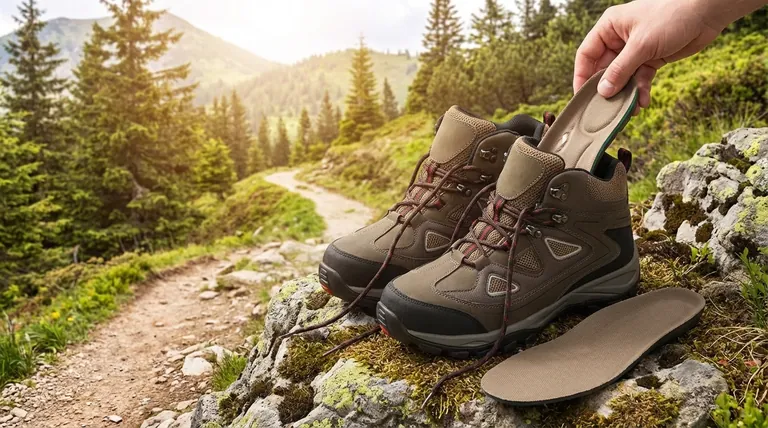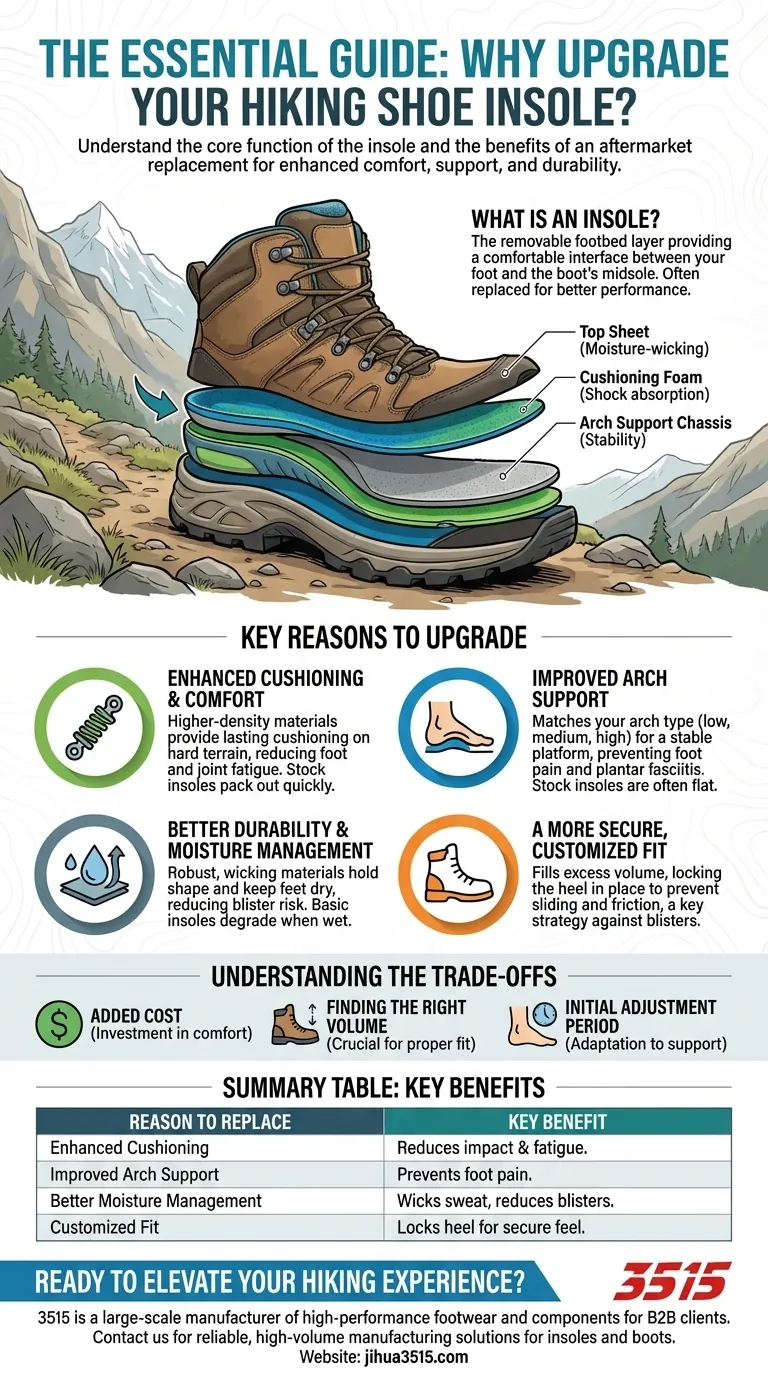At its core, an insole is the removable layer of material inside your hiking shoe that your foot rests directly upon. Often called a footbed, hikers frequently replace the basic "stock" insole that comes with the shoe for a more advanced aftermarket version to gain significant improvements in comfort, support, and durability on the trail.
The standard insole in a new hiking boot is often a generic, low-cost placeholder. Upgrading it is one of the most effective ways to customize the boot's fit and performance to match the specific needs of your foot.

The Role of the Stock Insole
A Basic Foundation
The insole is the interface between your foot and the boot's midsole. It is designed to provide a final layer of cushioning and a comfortable surface for your sock-lined foot.
Why They Are Often Replaced
Manufacturers typically include simple foam insoles that are designed to fit an "average" foot profile. They prioritize a soft initial feel in the store but often lack the structure and resilience needed for demanding hikes.
Key Reasons to Upgrade Your Insoles
Enhanced Cushioning and Comfort
Stock insoles can compress and "pack out" quickly, losing their ability to absorb shock. Aftermarket insoles use higher-density foams and materials that provide lasting cushioning on hard, rocky terrain, reducing fatigue in your feet and joints.
Improved Arch Support
This is the most critical reason for many hikers. Most stock insoles are completely flat, offering no real arch support. An aftermarket insole that matches your arch type (low, medium, or high) provides a stable platform, which can prevent foot pain and issues like plantar fasciitis.
Better Durability and Moisture Management
Basic insoles can degrade or bunch up when they get wet from sweat or water crossings, leading to discomfort and blisters. Insoles designed for hiking are built from more robust, moisture-wicking materials that hold their shape and performance when damp.
A More Secure, Customized Fit
A properly chosen insole can help fill excess volume inside a boot, locking your heel in place and preventing your foot from sliding forward on descents. This reduces friction and is a key strategy for preventing blisters.
Understanding the Trade-offs
The Added Cost
High-quality insoles represent an additional investment on top of the price of your boots. While they can dramatically improve comfort, this is a cost you must factor into your gear budget.
Finding the Right Volume
Insoles come in different thicknesses, or volumes. A high-volume insole placed in a low-volume boot can make the fit uncomfortably tight, creating pressure points. It's crucial to match the insole to both your foot and your footwear.
The Initial Adjustment Period
A highly structured, supportive insole can feel unfamiliar or even slightly uncomfortable at first compared to a soft, flat one. Your feet may need a few short walks to adapt to the new feeling of proper support.
Making the Right Choice for Your Goal
Upgrading your insole is about targeting a specific performance goal. Before buying, identify what problem you are trying to solve.
- If your primary focus is all-day comfort on moderate trails: A simple cushioned insole may be all you need to reduce impact.
- If your primary focus is long-distance backpacking with a heavy pack: Prioritize a durable insole with significant, structured arch support to prevent foot fatigue.
- If you have specific foot pain or a history of issues like plantar fasciitis: A rigid, orthotic-style insole will provide the stability and support necessary to protect your feet.
Personalizing your footwear is the first step toward more comfortable and capable hiking.
Summary Table:
| Reason to Replace Insole | Key Benefit |
|---|---|
| Enhanced Cushioning | Reduces impact and fatigue on hard terrain. |
| Improved Arch Support | Prevents foot pain and conditions like plantar fasciitis. |
| Better Moisture Management | Wicks away sweat, reducing blister risk. |
| Customized Fit | Locks heel in place for a more secure feel. |
Ready to elevate your hiking experience?
As a large-scale manufacturer, 3515 produces a comprehensive range of high-performance footwear and components for distributors, brand owners, and bulk clients. Whether you need custom insoles or complete hiking boots built for durability and comfort, our production capabilities deliver the quality and precision your customers demand.
Contact us today to discuss how we can support your product line with reliable, high-volume manufacturing.
Visual Guide

Related Products
- Safety Footwear Wholesale Manufacturer for Custom OEM/ODM Production
- Wholesale Safety Footwear Manufacturer for Bulk & Custom OEM Orders
- Factory-Direct Wholesale Canvas Boots with High-Traction Rubber Soles
- Premium Grain Leather Safety Boots for Bulk Supply
- High Performance Fire-Retardant Waterproof Safety Boots
People Also Ask
- What are the cultural perspectives on wearing shoes in the house? A Guide to Home Etiquette & Hygiene
- Do snake bite boots work? Your Ultimate Guide to Effective Snake Bite Protection
- Is it normal to wear shoes in the house? A Guide to Hygiene, Comfort & Culture
- What are the differences between steel toe, composite toe, and alloy toe Wellington boots? Choose the Right Safety Toe for Your Job
- Is safety-toe as good as steel toe? Choose the Right Protection for Your Job



















